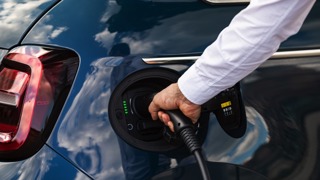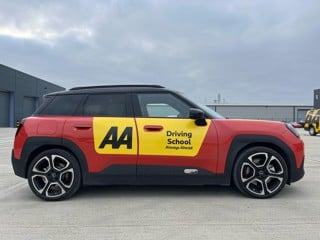Focus on technology and research is paying off for the automotive giant and its ever-expanding customer base
Multi-million pound investments in diagnostics, technology and back-office systems are driving improvements in service delivery to The AA’s fleet customers.
Stuart Thomas has been recently promoted to the role head of fleet services and SME at The AA. He oversees the fleet and business offerings of the automotive giant.
A continued focus on technology and research has been working well for the company, with the recent introduction of its multi-fit slim spare wheel reducing downtime for tyre-related incidents by as much as an hour.
Recent significant business wins include the breakdown and roadside assistance contract for vehicles managed and funded by FN50 number one Lex Autolease.
The new deal, which began in January, sees The AA supporting more than 300,000 vehicles across the UK.
The company has also retained manufacturer assistance contracts, and operates these in addition to its direct fleet and leasing accounts
“These partnerships show the breadth and depth of our relationship with the fleet industry. Though we’re a big consumer brand, we do have a focus on the fleet world,” Thomas says.
Fleet News: What practical benefits will fleets and drivers see as a result of your investments?
Stuart Thomas: We’ve had a big investment programme in our systems – around £150m in total – and a lot of that has gone into our call handling and deployment system.
The leasing industry is going through a lot of changes. Much of the industry is putting customers at the heart of their service, now it’s far less transactional and more holistic.
We have an online portal for leasing companies, which gives live access to data, and realtime access to their own fleet information.
The new system will allow leasing companies to deploy our technicians themselves. Previously, the call handler would take the call and then transfer it into our own centre, but we’re introducing the technology so they can handle it on one call.
The system will show their handlers where the resource is. The way we are successful is by supporting our customers to support their own customers.
We’ve also integrated our systems better with our app, to ensure we’re at the forefront of the digital era. There is a new fleet app on the way, which allows a fleet customer to choose what services their drivers can access.
We have spent a large amount installing Bosch diagnostics in our vans, along with new tablets. We used to give paper job sheets, but now that’s electronic – it’s making use of the technology available to improve the customer experience.
FN: How are you differentiating your telematics offering, and who is it targeted at?
ST: There’s a big focus on telematics and the connected car in the industry, and there are hundreds of suppliers of telematics. It’s normally sold as a product, there’s a list of things it will do.
The bigger fleets we’re talking to directly are well versed on telematics and its benefits, but the SME market is a really exciting area at the moment.
We’re putting together a more consolidated breakdown and telematics package for these businesses as well.
Our facility is integrated into the call centre, so if a call comes in, it will flag that the vehicle has telematics and allow access to all the benefits that offers in terms of remote fixes and location pinpointing.
There’s also a big piece of work we’re doing in terms of forward planning. We’re talking to manufacturer partners across Europe – for example looking at DPFs (diesel particulate filters) and battery condition.
It’s not going to eradicate breakdowns, but it could reduce them.
FN: Where do you see your place in the world of connected cars?
ST: There are a lot of interested parties when it comes to vehicle data. All the partners have to work together – it is not in their interests to make life difficult.
One of the biggest challenges is making sure drivers are aware of the technology, and how it will actually help them, not work against them.
FN: You currently have a big focus on supporting the SME market – what does that entail?
ST: We’ve been developing online renewals, a self-service option for fleets and a new mobile app.
Our AA Tyres service started as a retail offering, but when you’ve got a small fleet, the service works quite well, and allows us to respond better to tyre-related breakdowns.
FN: Flat tyres are still a major source of breakdowns – how are you helping to minimise their impact for larger fleets?
ST: There’s not one solution to a flat tyre, there are many. We can send a technician to change to a spare, we can plug the tyre, we can put a multi-fit wheel in place.
But that’s not the end of the problem for the driver. We are trying to look at the incident, and manage it effectively.
It’s very much our thinking where appropriate to support the process for the client. For example, if they have a contract with a tyre provider, to liaise with the provider and ensure the replacement tyre is ready.
If it’s late at night, we might instead help them arrange a hire car or travel to their onward destination. We can pass on details into a leasing company downtime management system, and help monitor and manage.
It’s a change in the way we think.
If someone has called us with a mechanical failure on their way to the airport, instead of just thinking about the breakdown, let’s send a taxi and get the driver to their destination and deal with the repair afterwards. Dealing with the breakdown first is ignoring the core problem.
FN: How have your partnerships and services developed in recent years?
ST: Certain patrols now carry a number of manufacturer parts, and are linked into warranty systems. If a warranty job comes in, we can cut out a visit to a dealer and reduce downtime. By fixing it, dealing with the warranty claim and putting it through the manufacturer system, it’s more efficient.
And our mobile services have expanded in other ways, too. We’ve got 60 fuel-assist vehicles for misfuelling, and a mobile key-cutting service for recoding and cutting of most keys, which is really powerful. We support a lot of rental and leasing companies with that service. We have a specialist battery assist service, which can get a battery out to the vehicle and replace it at the scene, minimising downtime.
The breadth and depth of services on offer to fleets from The AA is hard to match, but ultimately the organisation’s breakdown and recovery operation remains its best known capability.
The ability to call upon a service provider – and receive a speedy and effective response – in a time of difficulty is vital, and The AA’s technology investments look set to ensure that drivers are reached and diagnosed as swiftly and efficiently as possible.



















Login to comment
Comments
No comments have been made yet.